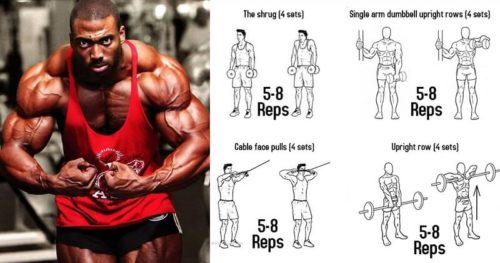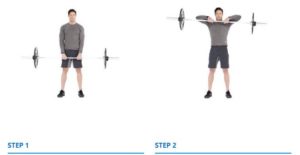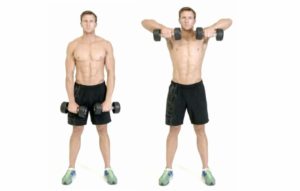The Benefit Of Building Bigger Traps:
One of the most important and beneficial reasons to build your traps is that, properly developed traps will help to stabilise and move the spine whenever movement is performed. This could be everyday activities or most importantly, whilst training.
Whenever the spinal column is required to not only support heavy loads, but move them, the traps, acting on the scapulae, are engaged to provide support. Functionally speaking, big, strong traps enable us to push and pull heavy weights.
The descending, upper region trapezius, is also engaged when the biceps and triceps are targeted. If you have a weak trapezius it may limit the amount of weight lifted for each of these key muscle groups and, may also limit muscle growth in these areas.
Well developed trapezius muscles, do benefit strength and posture but also promote mass appeal. So if you want a well balanced, round shapely upper half, include trap workouts to proportion and compliment your:
- Back.
- Biceps.
- Triceps.
- Chest.
- Shoulders.
This article is here to provide ideas on how best to build the traps, and how essential it is for complete muscular development. But never over develop them, as you need to build to full capacity if a proportionate, symmetrical physique is the aim.
Building Traps Correctly:
Whenever you train the back, the traps (which are part of the back complex), don’t always receive the specific stimulus needed to fully grow. This is because our larger, stronger muscles are engaged, but the traps must be prioritised with movements suited to their full recruitment.
The traps are part of the back complex, and do not work exclusively in isolation. Neither can the separate trapezius areas be strictly isolated with specific movements, but, there are ways we can emphasise the recruitment of the upper, middle and lower traps to reveal as much detail as possible in each.
Firstly, keep lifting heavy, basic movements such as:
- The bent over barbell row.
- Deadlift.
- Weighted chin-up.
These exercises are just a few that incorporate the entire trapezius and are essential for complete traps development. Though effective, a solid regime of mass building movements will define and build the traps only so much.
Top 4 Trapezius Exercises:
Dumbbell Shrugs:
How To Do: Dumbbell Shrugs
Probably the best traps movement of all time, when performed properly it targets the entire traps. Be sure to keep the elbows behind the body, rather than to the front, this will work all three sections of the trapezius.
- Stand straight with a dumbbell on each hand (palms facing your torso), arms extended on the sides.
- Lift the dumbbells by elevating the shoulders as high as possible while you exhale.
- Hold the contraction at the top for a second. Tip: The arms should remain extended at all times. Refrain from using the biceps to help lift the dumbbells. Only the shoulders should be moving up and down.
- Lower the dumbbells back to the original position.
- Repeat for the recommended amount of repetitions.
Behind The Back Barbell Shrugs:
An excellent all-round trap builder, this movement builds complete trapezius size and shape.
- Stand up straight with your feet at shoulder width as you hold a barbell with both hands behind your back using a pronated grip (palms facing back). Tip: Your hands should be a little wider than shoulder width apart. You can use wrist wraps for this exercise for better grip.
- Raise your shoulders up as far as you can go as you breathe out and hold the contraction for a second. Tip: Refrain from trying to lift the barbell by using your biceps. The arms should remain stretched out at all times.
- Slowly return to the starting position as you breathe in.
- Repeat for the recommended amount of repetitions.
Close Grip Barbell Upright Rows:
This movement hits the upper traps and the hard to reach frontal trap area above the clavicle region.
- Grasp a barbell with an overhand grip that is slightly less than shoulder width. The bar should be resting on the top of your thighs with your arms extended and a slight bend in your elbows. Your back should also be straight.
- Now exhale and use the sides of your shoulders to lift the bar, raising your elbows up and to the side. Keep the bar close to your body as you raise it.
- Continue to lift the bar until it nearly touches your chin. Tip: Your elbows should drive the motion, and should always be higher than your forearms. Remember to keep your torso stationary and pause for a second at the top of the movement.
- Lower the bar back down slowly to the starting position. Inhale as you perform this portion of the movement.
- Repeat for the recommended amount of repetitions.
Dumbbell Upright Rows:
Another upper trap builder, this movement allows for a greater range of motion on the upward phase.
- Grasp a dumbbell in each hand with a pronated (palms forward) grip that is slightly less than shoulder width. The dumbbells should be resting on top of your thighs. Your arms should be extended with a slight bend at the elbows and your back should be straight.
- Use your side shoulders to lift the dumbbells as you exhale. The dumbbells should be close to the body as you move it up and the elbows should drive the motion.
- Continue to lift them until they nearly touch your chin. Tip: Your elbows should drive the motion. As you lift the dumbbells, your elbows should always be higher than your forearms. Also, keep your torso stationary and pause for a second at the top of the movement.
- Lower the dumbbells back down slowly to the starting position. Inhale as you perform this portion of the movement.
- Repeat for the recommended amount of repetitions.
With all traps movements, you need to maintain the momentum, in a controlled way, from the beginning of the set to the end. No swinging and no resting at the bottom of the movement. If the weight you are using forces you to rest at the bottom, drop down to a lighter weight and continue the set until the prescribed rep range is achieved.
12 Week Trap Building Programme:
Trapezius training features in both shoulder and back training sessions. Because the traps are part of the back, they should be trained alongside the back workout to avoid potentially over training this area: (if we work traps with shoulders and train shoulders and back twice weekly, our traps are effectively trained 4 times per week. Also, by training traps with back you may lift heavier on all traps movements, and avoid injury, because the spinal area will be better lubricated and adequately warmed from the preceding back work.
For the purposes of the specialised traps training programme to follow, the traps will be worked once a week with back and additionally in their own separate workout.
s/w = super set with
Monday: Back & Traps
Train traps first in this workout and pick a back training workout of your choosing (if possible, be sure to include deadlifts and chins ups, as these work all major back muscles as well as significantly targeting the traps).
- Dumbbell Shrugs s/w Wide Grip Barbell Rows – 3 sets x 8-12 reps
- Behind the Back Barbell Shrugs – 3 sets x 8-12 reps
Tuesday: Arms
- Biceps/Triceps/Forearms – Exercises of choice to complete a workout.
Wednesday: Chest & Shoulders
- Exercises of choice to complete a workout.
Thursday: Rest
Friday: Traps
- Behind the Back Barbell Shrugs s/w Dumbbell Upright Rows – 4 sets x 8-12 reps
- Dumbbell Shrugs – 3 Drop Sets x 8-12 reps
- Wide Grip Upright Rows – 3 sets x 8-12 reps
Saturday: Legs
- Exercises of choice to complete a workout









Post your comment